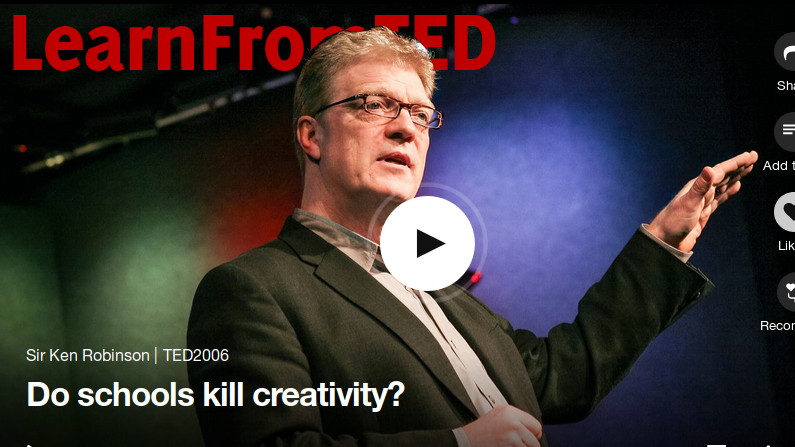A serie named #LearnFromTED cannot ignore the talk that has the highest ever number of views, currently over 57 millions, even more if we are talking about my absolute favourite TED presentation.
Sir Ken Robinson is telling us how the education system has some flaws like not developing creativity..
Why do I love so much this talk and of course I am not the only one by looking at how successful it is? Surely the content plays an important role, we are talking about a universal subject, education, with a vibrant idea and maybe controversial. Robinson received more than one critique in his career on this idea.
This is the first point we can take home: to involve a wide audience you need to speak about a topic that has to be interesting and comprehensible for the largest possible number of people. Be universal, both in the content and in how you delivery it, later we’ll see it explicitly. Not always our subject is so universal, so what should we do? We must approach it (the subject) so that it becomes relevant for a wider audience. We can try to leverage similar experiences the public may have (as Ken will do) or be straightforward in declaring how a specific idea could be applied in different contests related to them.
Another reason behind the popularity of this presentation is humour. At the 24th second people are already laughing and it will happen many times more. Who doesn’t like a giggle? If we manage to be funny we are to be listened to. In the following 90 seconds there are at least four other gags.
The introductions, that last almost to the end of the third minute (3:10) Robinson achieves different objectives:
- involve and engage the audience by talking about their resonance with education (01:42 – 02:20)
- use humour to capture even more attention (several times)
- make some references to what’s happening there at that time, like what he had heard from other speakers at that TED conference (00:30 – 01:00)
- clearly state his central theme statement, what he’s talking about and what message should the audience bring home (02:55 – 03:10)
At this time the opening is over and we get into what we call the body of the presentation, the part where the topic is covered in details.
The central section start with a couple more gags and just after that Ken begins with a story (03:32), well two of them (04:08) that happen to be: anecdotes, funny and strictly related with the point he wants to get across (05:22). The message is sustained by support information (05:45), note how the facial expression of Robinson changes, and how the vocal energy and the gestures underline the concept. It is also repeated for great emphasis (05:50).
The next lines reinforce what is presented as the problem: all kids are born creative people, education tends to squander this capacity. The next session (06:25) answers the question why this happens.
Even here there is a lot of humour, Shakespeare related, that is used to introduce another important idea: the foundation subjects of the education system are the same everywhere you go, no matter the place or the culture (08:30).
Just after (09:15) there is a beautiful graphic passage that builds on the previous one, where dance and body are mentioned. “…we start to educate them progressively from the waist up. And then we focus on their heads. And slightly to one side”. The same idea is reinforced immediately after (10:00).
Another sequence of gags (10:15) and the explanation why we face this problem (11:00), take notice of the inclusive plural used at a certain moment (12:00) “And I think we can’t afford to go on that way. ”.
Next he talks about multitasking mixing science and humour, at the start the latter seems to be more about his wife Terr, but then it shifts toward himself. If you you want to crack a laugh at someone when you present that’s the best target (yourself, not Ken!).
Then another story (15:00), and again a relevant anecdote dotted with fun. Repeating a concept is used also here to underline it to the audience “who had to move to think” (17:00).
This beautiful storytelling, strengthen Ken’s central theme statement and ends the body of the presentations, carrying us towards the end. There’s a funny remark (17:25) that let us smile, but also think, which evokes an applause from the audience.
The final part, normally called closing, it’s cued by Robinson “What I think it comes to is this” (17:40). It’s a good technique to alert your public that we are going to end soon and raise their attention, although this time I am confident everyone was completely focused. Even here you can find several references to other things said during the conference. It’s a great thing to do because it gives the audience a sense of living the moment, making the talk more engaging and avoiding any possible perception of pre-cooked speech.
The closing is strong and direct, exactly how it should be, to deliver a powerful message to 57,177,584 listeners. All TED talks can benefit from on-line exposure, this one stands on top of all, why?
Surely it is a speech very well structured, we have just seen it. The stories that are told are fascinating and make us want to listen to Robinson. The strong presence of humour is not hindering and is one success factor. The disrupting power of the idea and its universality is what makes the difference. Commonplace or trite message won’t set the public on fire no matter how well delivered, and neither topics unrelated to them. To move audiences you need to dare, push their minds on something that they can feel and do it with passion and intellectual honesty. This is the main lesson we can learn from Sir Ken Robinson


Recent Comments